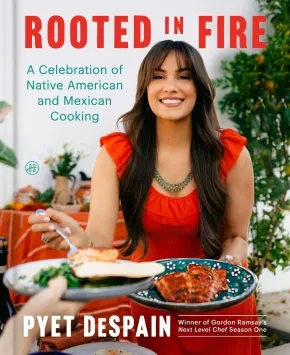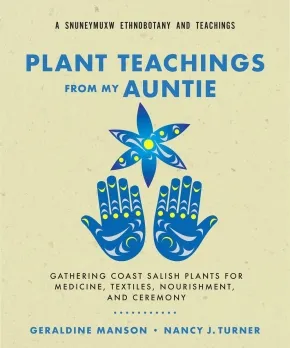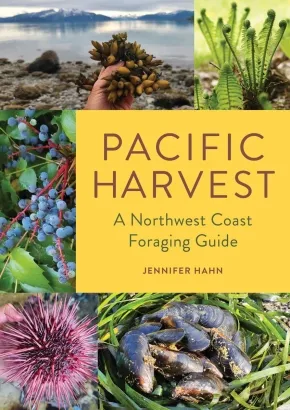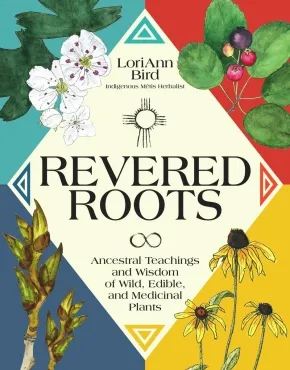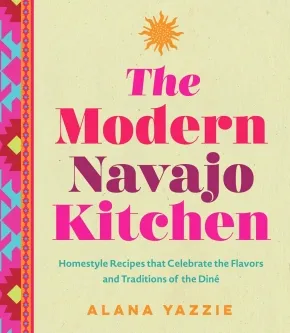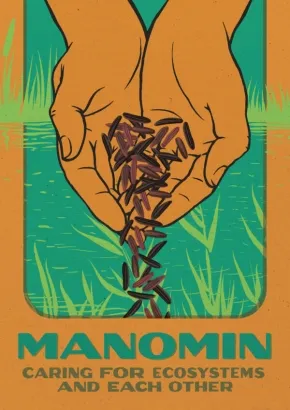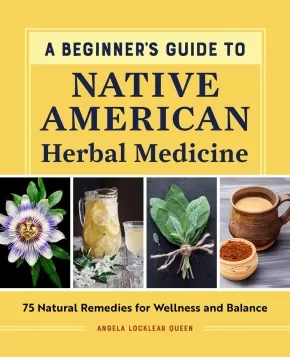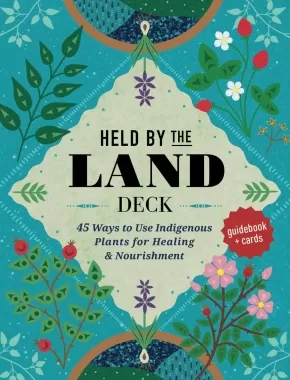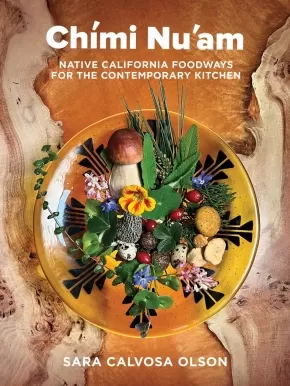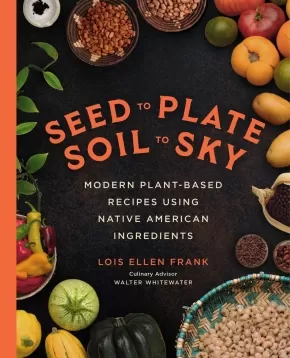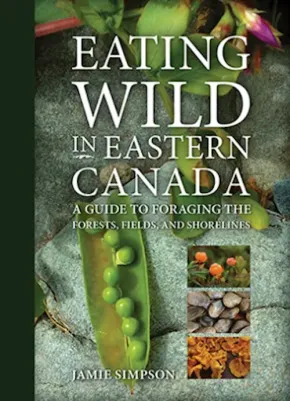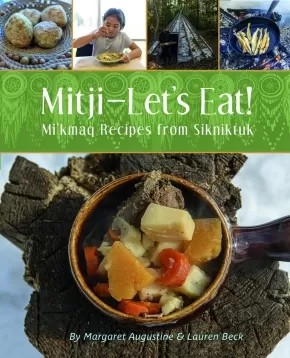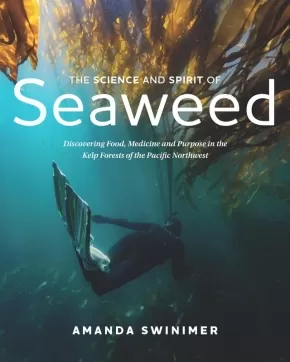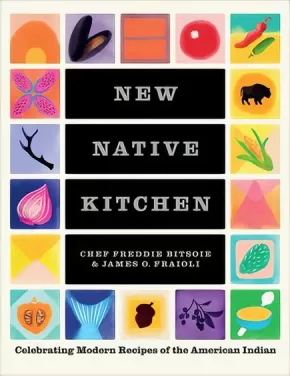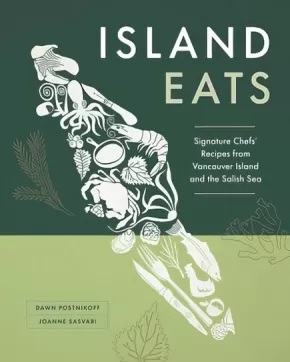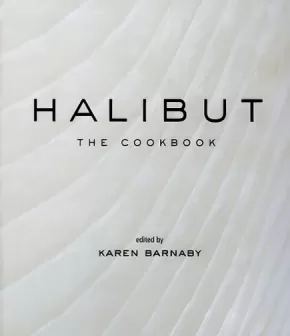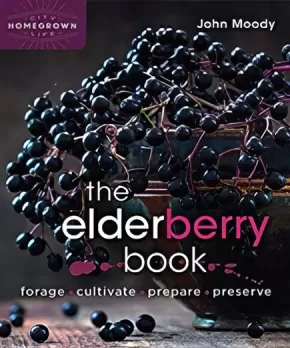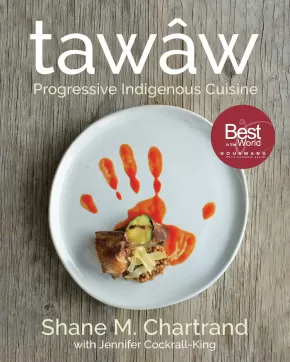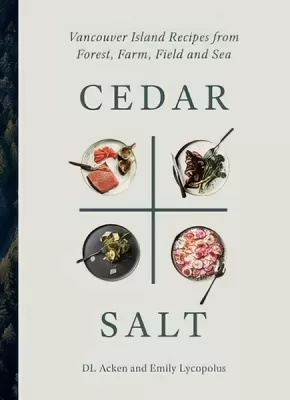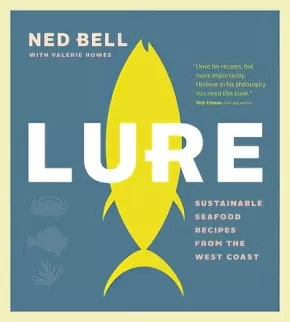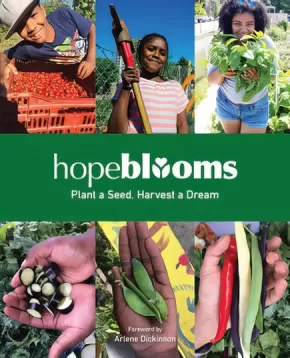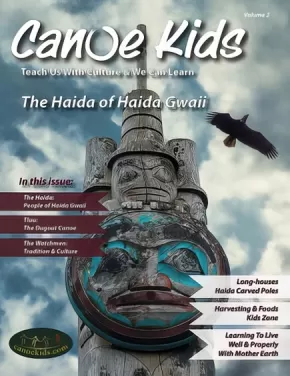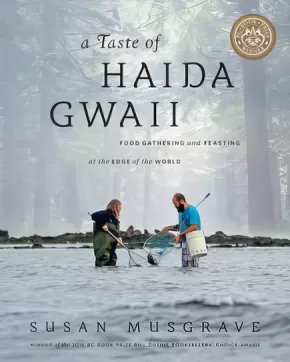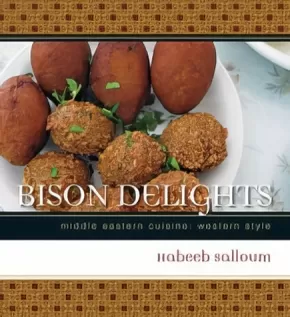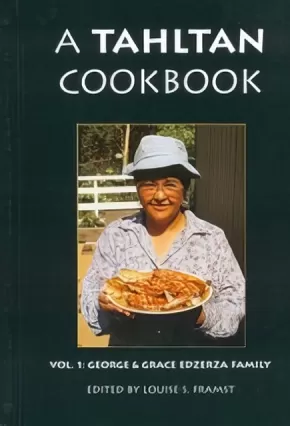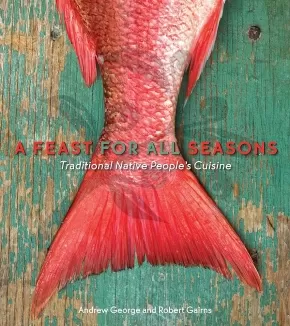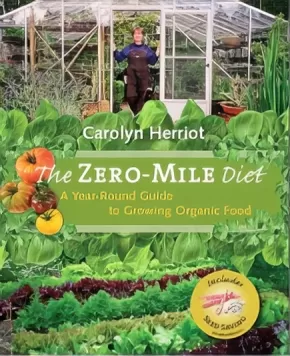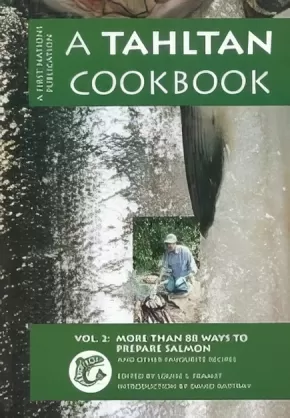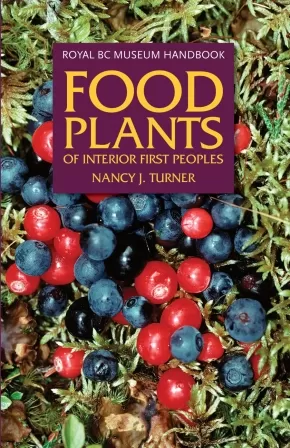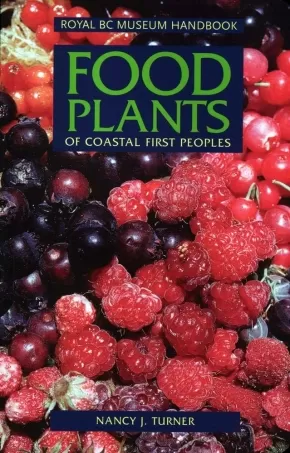
Culinary
1
-
15
of
39 Results;
Sort By
Go To
of 3
Rooted in Fire: A Celebration of Native American and Mexican Cooking
$43.50
Format:
Hardcover
Reading Level: N/A
ISBN / Barcode: 9780063304079
Synopsis:
Synopsis:
Next Level Chef winner Pyet De Spain celebrates her Mexican and Native American heritage in this collection of mouthwatering recipes, a vibrant fusion that ties us to the land and to one another.
Star chef Pyet DeSpain rose to prominence as the first winner of Gordon Ramsey’s Fox television show Next Level Chef. Now, in her debut cookbook, she shares the joy of cooking fueled by her burning passion for Native American and Mexican American cuisine. Rooted in Fire: A Celebration of Native American and Mexican Cooking is a tribute to her dual heritage—a gorgeously crafted celebration of the diversity of food and the stories, traditions, culture, and profound philosophies of Indigenous people that season each meal.
Pyet shows you how to incorporate a delicious range of key ingredients—from venison, dandelion greens, to sunchokes, bison, and native berries—into more than sixty fusion dishes. Family and friends will be excited to gather around the table to enjoy sweet and savory food such as:
- Three Sisters Salad
- Bison and Sweet Corn Soup
- Fry Bread
- Mexican Chocolate & Mezcal Cake
- Corn Silk and Honey Tea
- Wojapi BBQ Sauce
In addition to her inventive and palate pleasing recipes, Pyet invites home cooks to honor the seasons on our beautiful Earth and connect with essential foodways. “This is more than just a cookbook,” Pyet writes. “It’s giving a voice to Indigenous people, while also highlighting the fusion of my two cultures with fire and purpose.”
Reviews
"Pyet's talent is evident in every recipe in this book. The way she weaves her heritage into her dishes is extraordinary and I've seen it every day since the first time I tasted her work on Next Level Chef. Trust me, you're in for an absolute treat." — Gordon Ramsay
Pyet’s Rooted in Fire beautifully honors her Prairie Band of Potawatomi and Mexican heritage through food storytelling that is both personal and powerful. Her voice is heartfelt, her vision and dedication are clear, and her talent within the Indigenous food movement is undeniable. I’m so proud to see her shining as a modern-day Indigenous food warrior—this book marks an important chapter in her growing legacy." — Sean Sherman, Founder of The Sioux Chef/NATIFS.org and Author of The Sioux Chef’s Indigenous Kitchen and Turtle Island
Additional Information
288 pages | 7.38" x 9.12" | 128 four color food photographs | Hardcover
Plant Teachings from My Auntie: Gathering Coast Salish Plants for Medicine, Textiles, Nourishment, and Ceremony
$24.99
Format:
Paperback
Text Content Territories:
Indigenous Canadian; First Nations; Salish; Coast Salish; Snuneymuxw ;
Reading Level: N/A
ISBN / Barcode: 9781774060322
Synopsis:
Synopsis:
A Snuneymuxw ethnobotany guide grounded in Indigenous knowledge and deep ancestral connection to the land.
Plant Teachings from My Auntie: Gathering Coast Salish Plants for Medicine, Textiles, Nourishment, and Ceremony is a richly illustrated compendium of the many culturally significant wild foods and herbal remedies found in the traditional territory of the Snuneymuxw First Nation.
Each entry features plant descriptions complete with both their Hul'q'umi'num and botanical names, typical native habitat, and traditional uses. Particular attention is paid to the sacred Western Red Cedar or "tree of life." The book also offers a selection of healing recipes; tips for respectful, sustainable harvesting; ethical and responsible preparation techniques; and a guide to local gathering sites.
Snu'y'ulh refers to teachings handed down through generations. Snuneymuxw Elder and Knowledge Keeper Geraldine Manson, whose traditional name is C'tasi:a, draws on the sacred knowledge passed on to her by her "Auntie Ellen," Dr. Ellen White, also known as Kwulasulwut. Central to these learnings is the fundamental concept or protocol of honoring gifts from the land by gathering and preparing in ways that respect the history, culture, spirituality, and Indigenous knowledge associated with each species.
This powerful work is a rare treasure that will appeal to those seeking to foster greater cultural understanding and ecological responsibility while deepening their commitment to meaningful reconciliation.
Additional Information
96 pages | 9.00" x 7.50" | Paperback
Pacific Harvest: A Northwest Coast Foraging Guide
$40.95
Format:
Paperback
Text Content Territories:
Indigenous Canadian; Indigenous American;
Reading Level: N/A
ISBN / Barcode: 9781680516685
Synopsis:
Synopsis:
This guide:
- Highlights 70-plus edible species including seaweeds, beach vegetables, shellfish, mushrooms, berries, trees, ferns, and wild and weedy greens
- Includes more than 60 recipes, plus tips for enjoying this natural abundance
- Includes key sections describe sustainable harvesting practices
Pacific Harvest, written by expert forager and guide Jennifer Hahn, introduces both novice and more experienced foragers to the Pacific Coast’s ample and diverse edible species. Recognizing your local edible berries, flowers, greens, roots, tree parts, mushrooms, seaweeds, beach vegetables, and shellfish is a passport to a comforting sense of place. Hahn shares immersive descriptions of her foraging adventures as well as full-color photos to make identifying these species easy and enjoyable. Each featured food listing includes common names, taxonomy, primary location, description, harvesting details, and culinary tips for transition from the wild to the kitchen table. Select listings call out notable nutrition and wellness benefits, along with contemporary research on conservation status.
This coastal foraging guide highlights authentic Indigenous harvesting practices including profiles of Indigenous leaders in the traditional foods movement. Hahn emphasizes a sustainable approach to foraging, reminding readers what other beings also depend on these plants and animals as food and shelter sources.
Pacific Harvest includes dozens of recipes featuring foraged foods, ranging from no-fuss delights like Salal Berry Scones and Kelp-Wrapped Salmon to comfort foods like Fiddlehead Quiche and Horse Clam Stir-Fry.
Additional Information
360 pages | 6.00" x 8.50" | 175 Color Photos | Paperback
Revered Roots: Ancestral Teachings and Wisdom of Wild, Edible, and Medicinal Plants
$32.99
Format:
Hardcover
Text Content Territories:
Indigenous Canadian; Métis;
Reading Level: N/A
ISBN / Barcode: 9780760393253
Synopsis:
“Revered Roots is a profound journey that gracefully and colorfully intertwines Indigenous wisdom with practical plant knowledge, offering a guide to reconnect with Nature’s green gifts. LoriAnn's heartfelt teachings inspire readers to honor and deepen their sacred relationship with the Earth.”—Dr. Kelly Ablard, Founder and CEO, Airmid Institute
Synopsis:
With Indigenous Métis herbalist LoriAnn Bird as your guide, connect with the ancestral wisdom of over 90 wild edible and medicinal plants from across North America.
A purposeful and powerful reference to the lessons, nourishment, healing, and history of our “plant teachers,” Revered Roots shares guidance on exploring, gathering, and reclaiming these long-revered plants as food and medicine. Separated into two sections, LoriAnn first reveals her own journey to understanding and respecting our plant elders. She offers teachings and lessons about remembering our relationship to the plants around us and our responsibility to the earth that sustains us.
The second part of the book is filled with insightful illustrated plant profiles detailing the identification, uses, and Indigenous folklore of some of the continent’s most treasured ancestral plants. Included are edible and medicinal bark, berries, and buds from trees and shrubs, as well as foliage, flowers, and fronds from herbs, “weeds,” and wildflowers; some native to the continent, others introduced generations ago.
Learn about the gifts our Rooted Nation of plants has to offer, including:
- Evergreen tips from spruces, pines, and firs
- Hawthorn berries, leaves, and flowers
- Plantain seeds and foliage
- Oswego tea leaves and blooms
- Slippery elm bark
- Motherwort flowers, stems, and leaves
- Black cohosh roots and rhizomes
- Marshmallow root
- Cottonwood buds and bark
- Plus dozens more
Reclaiming our natural rhythms and connections to the earth we walk on is essential to our health and well-being, both as individuals and as a community. One simple way to do that is by appreciating, respecting, and seeking to understand the plants around us.
Reviews
“With elegant reverence, LoriAnn Bird weaves connections among ancestral herbalist teachings from several lineages. She invites us into our own personal journey with plant medicine, giving us lessons on how to respect and honor the power of plants and their human knowledge keepers. She carefully and lovingly attributes each piece of teaching to its source. This book is a powerful legacy that we need more than ever at this time of healing and reconciliation. May its words fly into the world and land softly in the hearts of all who need them.”—Lori Weidenhammer, author of Victory Gardens for Bees: A DIY Guide to Saving the Bees
“Revered Roots is truly an essential work of art that imparts the sacredness of each plant, in each harvesting step and in the interspecies relationships with all of life. The authentic and grounded nature of LoriAnn Bird comes through the pages to connect us with a sense of belonging and reverence.”—Katrina Blair, founder of Turtle Lake Refuge; author of The Wild Wisdom of Weeds
“LoriAnn Bird, in her book Revered Roots, creates a beautiful story about our plant relatives with our history woven between the leaves of each page. She highlights each being and allows them to tell their story, including who they are, their benefits, uses, ways to eat, look-alikes, and what makes them unique. It's like looking at an old family album and finally knowing who each person is and what their spirit has to offer the world. The book, complete with information about our relatives, wrapped its warm arms around me as I nestled in to read each page, excited to learn more about family. LoriAnn’s voice provides a continuous honoring of our ancestors, our brilliance, and our resilience.”—Jenna Jasek, Shuswap (Kenpesq't) Band member, Director of Indigenous Learning, The Outdoor Learning School
“Revered Roots is a profound journey that gracefully and colorfully intertwines Indigenous wisdom with practical plant knowledge, offering a guide to reconnect with Nature’s green gifts. LoriAnn's heartfelt teachings inspire readers to honor and deepen their sacred relationship with the Earth.”—Dr. Kelly Ablard, Founder and CEO, Airmid Institute
“LoriAnn Bird weaves stories of plants into a tapestry of vivid imagery and teachings, allowing us to experience earth medicine in a way we never have before. Like a family gathered around the table exchanging stories of cherished ones, Lori Ann’s plant musings draw us into an intimate connection with our More-Than-Human Kin. From a small moment in a back alley in East Vancouver to hundreds of years of history from around the world, Revered Roots feels like an equal blend of encyclopedia, history book, and love letter. Get to know plants in a truly profound way through the words of a master storyteller, sister, friend, mother, and plant protector.”—Stephanie Rose, founder of Garden Therapy; author of Garden Alchemy and The Regenerative Garden
“This is a beautiful book on every level; the gorgeous drawings and painting of plants, the photography and images throughout, but also the words and the feelings on each page. Intensely moving and remarkably practical, deeply personal and filled with worldly wisdom, this book offers the reader a glimpse into a whole new way of seeing the nature. With a plant centered focus, through a biophilia lens, the author invites us to re-evaluate and re-vision our own relationships with plants and the natural world. This book is destined to be a classic.”—Chanchal Cabrera MSc, FNIMH, Medical Herbalist; Horticulture Therapist; author of Holistic Cancer Care
“LoriAnn has put a lifetime of collected knowledge into a work that connects people to plants in ways both honorable and honest. Revered Roots extols both the practical and sacred uses of the plants we see around us, while also nurturing our respect for our More-Than-Human Kin and our responsibility to the greater world. It has been a pleasure to be a teacher and herbal mentor to LoriAnn for many years.”—Don Ollsin, Master Herbalist; Conscious Spiritual Elder, Alchemy of Aging; author of Pathways to Healing
Additional Information
240 pages | 8.00" x 9.55" | Hardcover
The Modern Navajo Kitchen: Homestyle Recipes that Celebrate the Flavors and Traditions of the Diné
$32.99
Format:
Hardcover
Text Content Territories:
Indigenous American; Native American; Navajo (Diné);
Reading Level: N/A
ISBN / Barcode: 9781577154679
Synopsis:
Synopsis:
Nourish your body and mind through food with these 60 recipes celebrating Navajo culinary traditions.
The Modern Navajo Kitchen takes you on an exhilarating journey for your taste buds. This beautifully photographed cookbook ties together traditional Navajo recipes as well as global recipes with a Navajo spin, creating a truly unique culinary experience! Choose from a plethora of drinks, breads, breakfasts, soups, mains, sides, and desserts—the sky’s the limit.
Incorporating traditional and modern ingredients, some of the deliciously nourishing and comforting recipes include:
- Navajo Boba Milk Tea (Abe’ Boba Dééhk’azí)
- Fry Bread (Dah Díníilghaazh)
- Navajo Burgers (Atsį’ Yik’ą́ Náneeskadí Bił Ałch’į’ Át’éhí)
- Sumac and Strawberry Greek Yogurt Ice Pops (Chiiłchin Yogurt Tiní)
- and more!
This comprehensive cookbook also includes instructions for how to make such things as juniper ash, roasted cornmeal, and roasted chiles that will bring your Navajo cooking skills to the next level. A short history of Navajo culinary traditions is provided to provide cultural context behind your new culinary experiences, and sample meal plans will help you put together the perfect menus for the week ahead or for those special occasions with family and friends.
Reconnect to your cultural heritage or treat your palate (or both!) with The Modern Navajo Kitchen.
Additional Information
192 pages | 8.00" x 9.50" | Colour Photos | Hardcover
Manomin: Caring for Ecosystems and Each Other
$29.95
Editors:
Format:
Paperback
Text Content Territories:
Indigenous Canadian; First Nations; Anishinaabeg;
Reading Level: N/A
ISBN / Barcode: 9781772840902
Synopsis:
Synopsis:
Reclaiming crops and culture on Turtle Island
Manomin, more commonly known by its English misnomer "wild rice," is the only cereal grain native to Turtle Island (North America). Long central to Indigenous societies and diets, this complex carbohydrate is seen by the Anishinaabeg as a gift from Creator, a "spirit berry" that has allowed the Nation to flourish for generations. Manomin: Caring for Ecosystems and Each Other offers a community-engaged analysis of the under-studied grain, weaving together the voices of scholars, chefs, harvesters, engineers, poets, and artists to share the plant's many lessons about the living relationships between all forms of creation.
Grounded in Indigenous methodologies and rendered in full colour, Manomin reveals and examines our interconnectedness through a variety of disciplines-history, food studies, ethnobotany, ecology-and forms of expression, including recipes, stories, and photos. A powerful contribution to conversations on Indigenous food security and food sovereignty, the collection explores historic uses of Manomin, contemporary challenges to Indigenous aquaculture, and future possibilities for restoring the sacred crop as a staple.
In our time of ecological crisis, Manomin teaches us how to live well in the world, sustaining our relations with each other, our food, and our waterways.
Reviews
"This book is absolutely amazing and one of the most original collections that I have read in many years. Intended for everyone who inhabits Turtle Island-Indigenous and settler alike-Manomin encourages readers to develop deeper relationships and understandings by listening to Elders and the land. I believe Manomin will transform Indigenous scholarship." — Michael Dockry, University of Minnesota
"Manomin teaches us much; how to observe, the need for biodiversity, and the understanding that there will be rice somewhere else, on different years, based on water levels. Manomin has provided food during the harshest of times. We were told that we should care for our water and there would be rice. There are lakes where Manomin has been drowned by the state and provincial authorities, raising water levels for recreational boats. For many years the Mille Lacs band of Anishinaabe tried to get the water levels corrected for the rice to flourish on Onamia and Omeme Lakes. At one of those lakes, the water levels went down in a drought, and the Manomin returned, seventeen years later. At another lake it was fifty years later. The Manomin returned when the conditions were right. That reminds us, like this book, of the resilience of seeds, the resilience of life, and our agreement to care for all. This book is a blessing of teachings and acknowledgment for the great gift of Manomin." — Winona LaDuke, To Be a Water Protector: Rise of the Wiindigoo Slayers
Educator Information
Topics: Environmental Studies, History, Indigenous Studies, Decolonization, Agriculture and Food, Ethnobotany, History, Food Studies.
Table of Contents
List of Illustrations
A Note on Language by Brittany Luby and Margaret Lehman
Introduction by Brittany Luby, Samantha Mehltretter, and Margaret Lehman with Niisaachewan Anishinaabe Nation
Ch.1 Manitou Gitaggan, the Great Spirit’s Garden by Kezhii’aanakwat Ron Kelly, Giizhiigokwe Sandra Indian, Patees Dorothy Copenace, and Kathi Avery Kinew
Ch.2 Migration by Edward Benton-Banai
Ch.3 Seeds and Soils by Victoria Jackson
Manomin and Bergamot by Sean Sherman
Ch.4 Manomin as Teacher by Brittany Luby with Niisaachewan Anishinaabe Nation
Images from Anishinaabe-Aki: Harvest
Ch.5 Relational Vocabularies by Joseph Pitawanakwat
Manomin, Berries, and Love by Michelle Johnson-Jennings, PhD
Ch.6 Environmental Change, Environmental Care by Samantha Mehltretter and Andrea Bradford with Niisaachewan Anishinaabe Nation
Images from Anishinaabe-Aki: The Seasons by Andrea Bradford
Ch.7 Disconnection by Hannah Tait Neufeld
Manomin and Mushrooms by Shane Chartrand
Ch.8 Treaty and Mushkiki by Jana-Rae Yerxa and Pikanagegaabo, William Yerxa
Ch.9 Promise by Kristi Leora Gansworth
Epilogue by Andrea Bradford and Brittany Luby
Appendix 1: A Recipe for Corn Soup
Appendix 2: A Note on Indigenous Language Rights
Glossary by Jane Mariotti
Contributors
Notes
Selected Bibliography
Additional Information
240 pages | 6.00" x 8.50" | 40 colour illustrations, 2 maps, index, bibliography | Paperback
A Beginner's Guide to Native American Herbal Medicine: 75 Natural Remedies for Wellness and Balance
$25.99
Format:
Paperback
Text Content Territories:
Indigenous American; Native American;
Reading Level: N/A
ISBN / Barcode: 9798886501278
Synopsis:
Synopsis:
Improve your well-being with Native American herbal medicine
Native American herbal medicine offers a powerful way to connect with the earth and heal naturally—and with this handbook of Native American herbs, you can learn all about herb uses and their restorative effects. Written by an Indigenous herbalist, this guide shows you how to responsibly use traditional plants to treat anxiety, colds, inflammation, and more.
This standout among books about herbs and healing will help you:
- Learn about a time-honored practice—Discover the origins and healing secrets of Native American herbalism, its traditional and modern uses, and how tools like the medicine wheel teach us about our relationship with the natural world.
- Identify the essential herbs—Explore the healing properties of medicinal herbs for wellness, from anise hyssop to yerba santa.
- Make 75 natural remedies—Ease physical and emotional ailments with Native American remedies, like Memory Support Tea, Stress-Induced Headache Tincture, and Antibacterial Healing Herb Liniment.
Tap into traditional wisdom with this Native American herbal medicine book for health and well-being.
Reviews
"A beautiful jumping-off point for anyone who is interested in practical herbalism. Angela organizes the wisdom of Native American herbalism in a way that is accessible for anyone to pick up and fold into their everyday life." —Kathleen Lee, acupuncturist, herbalist, and spiritual business mentor
"Angela is a wise and fierce protector of plant medicine and traditions of healing. Her first book, A Beginner's Guide to Native American Herbal Medicine, is a meaningful, accessible resource for readers who seek to ground themselves in understanding and build an herbal practice of integrity." —Graham Wesley
Additional Information
165 pages | 7.50" x 9.25" | full-colour photographs throughout | Paperback
Held by the Land Deck: 45 Ways to Use Indigenous Plants for Healing & Nourishment - Guidebook + Cards
$25.99
Format:
Paperback
Text Content Territories:
Indigenous Canadian; First Nations; Salish; Coast Salish; Squamish;
Reading Level: N/A
ISBN / Barcode: 9781577154440
Synopsis:
Synopsis:
Have Indigenous plant knowledge at your fingertips with this gorgeously illustrated card deck from Leigh Joseph, an ethnobotanist and a member of the Squamish Nation.
Plants can be a great source of healing as well as nourishment, and the practice of growing and harvesting from trees, flowering herbs, and other plants is a powerful way to become more connected to the land. The Indigenous Peoples of North America have long traditions of using native plants as medicine as well as for food. Held by the Land Deck includes 45 cards of indigenous plants and their properties and a 48-page booklet to guide you along the way. Here are some of the things you will find:
- Tips to build your own home apothecary
- Notes on how to mindfully harvest and connect to the land you’re on
- Recipes for infused oils and salves
- A botanical glossary to help out with some of the more technical language
- Checklists for safe and sustainable harvesting
This beautifully illustrated card deck includes plants that are culturally significant to the Pacific Northwest, including Western Red Cedar, Devil’s Club, Broad-Leaved Plantain, Camas, Wapato, and Red Laver. Special features in the booklet include recipes for food and beauty products along with stories and traditions around the plants.
This elegant, full-color card deck and booklet is your go-to guide for Indigenous plants and will give you new insights into the power of everyday nature.
Additional Information
48 pages | 4.50" x 5.90" | 45 Cards and 48-Page Booklet
Chimi Nu'am: Native California Foodways for the Contemporary Kitchen
$62.50
Format:
Hardcover
Text Content Territories:
Indigenous American; Native American; Karuk;
ISBN / Barcode: 9781597146159
Synopsis:
Synopsis:
More than seventy delectable recipes that bring California’s Indigenous cuisines into kitchens today.
In this sumptuous cookbook, Sara Calvosa Olson (Karuk) reimagines some of the oldest foods in California for home cooks today. Meaning “Let’s eat!” in the Karuk language, Chími Nu’am shares the author’s delicious and inventive takes on Native food styles from across California. Over seventy seasonal recipes centered on a rich array of Indigenous ingredients follow the year from Fall (elk chili beans, acorn crepes) to Winter (wild boar pozole, huckleberry hand pies) to Spring (wildflower spring rolls, peppernut mole chicken) to Summer (blackberry braised smoked salmon, acorn milk freezer pops). Special sections offer guidance on acorn preparation, traditional uses of proteins, and mindful ingredient sourcing. Calvosa Olson has spent many years connecting her family’s foodways with a growing community, and these recipes, techniques, and insights invite everyone to Calvosa Olson’s table. Designed as an accessible entry for people beginning their journey toward a decolonized diet, Chími Nu’am welcomes readers in with Calvosa Olson’s politically attuned and irresistibly funny writing. With more than 100 photographs, this cookbook is a culinary gift that will add warmth and mouthwatering aromas to any kitchen.
Reviews
"This cookbook designed to uplift Indigenous California foods will delight foragers, adventurous home cooks, and those looking to connect with Native roots. It's a valuable addition to library shelves that will connect Native and non-Native Americans to the earth and its abundant gift of ingredients." —Library Journal
"With Chími Nu'am, Olson looks to encourage people to start thinking about a decolonized diet, connecting to the land and native ingredients prior to European colonization [... and] aims to make Indigenous ingredients and traditional Karuk recipes accessible to a whole range of home cooks." —Nina Friend, BBC World's Table
"Chími Nu’am is serious about taking a holistic view of reintegrating the healthfulness of traditional diets into modern lives, benefiting both personal well-being and the greater good." —Naomi Tomky, Atlas Obscura
"Calvosa Olson has written a book that will speak to multiple audiences. But whether she's guiding Indigenous readers to embrace more of their cultural foods or making recommendations for non-Indigenous readers interested in decolonizing their diets in an ethical way (hint: it's about reciprocity), her voice and philosophy come through clearly on the page." —Twilight Greenaway, Civil Eats
"To say that Chími Nu'am is just a cookbook is inaccurate. What took Calvosa Olson more than two years to write and publish is an expression of her life and an act of stewardship for the earth. [...] The author was raised to believe that if you take care of the land, the land will take care of you." —Prism
"Calvosa Olson invites readers to forage for and become more attuned to Indigenous and seasonal ingredients—nurturing a deeper connection to place and enhancing one’s role as an environmental steward." —Uprooted
"Connecting with nature is an approach to cooking that is often overlooked—but not for Sara Calvosa Olson. A native Californian raised by a Karuk mother, she is leading people on a path to decolonize their diets, one cup of manzanita flour at a time." —KCRW Good Food
"Connection to people and planet is central to both Calvosa Olson's personal approach to food as well as the message of Chími Nu'am." —Rachel Askinasi, The Messenger
"Besides being a creative, accessible cookbook, Calvosa Olson's work is a call for stewardship of the environment and an introduction to some local foods that have long been part of Native diets. It’s a terrific resource for foragers, teachers, libraries, classrooms, cooks, and anyone looking to learn more about the foodways of California's Indigenous peoples." —Edible East Bay
Additional Information
288 pages | 7.50" x 10.00" | Hardcover
Seed to Plate, Soil to Sky: Modern Plant-Based Recipes Using Native American Ingredients
$38.00
Format:
Hardcover
Text Content Territories:
Indigenous American; Native American;
ISBN / Barcode: 9780306827297
Synopsis:
Synopsis:
This enriching cookbook celebrates eight important plants Native Americans introduced to the rest of the world: corn, beans, squash, chile, tomato, potato, vanilla, and cacao—with more than 100 recipes. When these eight Native American plants crossed the ocean after 1492, the world’s cuisines were changed forever. In Seed to Plate, Soil to Sky, James Beard Award-winning author and chef Lois Ellen Frank introduces the splendor and importance of this Native culinary history and pairs it with delicious, modern, plant-based recipes using Native American ingredients. Along with Native American culinary advisor Walter Whitewater, Seed to Plate, Soil to Sky shares more than 100 nutritious, plant‑based recipes organized by each of the foundational ingredients in Native American cuisine as well as a necessary discussion of food sovereignty and sustainability.
A delicious, enlightening celebration of Indigenous foods and Southwestern flavors, Seed to Plate, Soil to Sky shares recipes for dishes such as Blue Corn Hotcakes with Prickly Pear Syrup, Three Sisters Stew, and Green Chile Enchilada Lasagna, as well as essential basics like Corn Masa, Red and Green Chile Sauces, and Cacao Spice Rub. The “Magic 8” ingredients share the page—and plate—to create recipes that will transform your world.
Reviews
"Seed to Plate honors the practical side of growing Indigenous heirloom seeds to fruition. Lois demonstrates how to respect the whole life cycle of these foods by processing and cooking them with reverence, so when they end up on our plate and in our bellies, they are true medicine. This book honors Native American food wisdom and transforms the way we think about daily nourishment.” —from the foreword by Melissa K. Nelson, (Anishinaabe/Métis [Turtle Mountain Chippewa]), Professor of Indigenous Sustainability, Arizona State University; President of the Cultural Conservancy"
"Seed to Plate, Soil to Sky is more than a beautiful and empowering book. It is a landmark in the culinary world, helping us remember timeless traditions and put them to use at a time when healthful traditions are needed most. It is a treasury of historical context, key botanical information, and practical tips for the kitchen that will allow us to use the bounty of nature for health and vitality."—Neal D. Barnard, MD, FACC, adjunct professor of medicine, George Washington Univ. School of Medicine & Health Sciences, president, Physicians Committee for Responsible Medicine
Additional Information
320 pages | 7.60" x 9.40" | 75 full colour photos | Hardcover
Eating Wild in Eastern Canada: A Guide to Foraging the Forests, Fields, and Shorelines
$22.95
Format:
Paperback
Reading Level: N/A
ISBN / Barcode: 9781771085984
Synopsis:
Synopsis:
From fiddleheads to spruce tips, wild food can be adventurous and fun--with the right guide. In Eating Wild in Eastern Canada, award-winning author and conservationist Jamie Simpson shows readers what to look for in the wilds and how and when to collect it.
Grouping foods by their most likely foraging locations—forests, fields, and shorelines—and with 50 full-colour photographs, identification is made accessible for the amateur hiker, wilderness enthusiast, and foodie alike. Includes historical notes and recipes, cautionary notes on foraged foods' potential dangers, and interviews with wild-edible gatherers and chefs. While gathering wild edibles may be instinctive to some, there is an art to digging for soft-shelled clams and picking highbush cranberries, and Simpson joyfully explores it in this one-of-a-kind narrative guidebook.
Additional Information
152 pages | 6.50" x 9.00" | Paperback
Mitji- Let's Eat!: Mi'kmaq Recipes from Sikniktuk
$29.95
Artists:
Format:
Paperback
Text Content Territories:
Indigenous Canadian; First Nations; Mi'kmaq;
Reading Level: N/A
ISBN / Barcode: 9781774712276
Synopsis:
Synopsis:
An intergenerational source of wisdom and knowledge, Mitji combines a cultural history of Mi'kmaw cuisine with a practical cookbook.
The welcome call of "Mitji" can be heard by Mi'kmaw children, hungry workers, family, and friends when dinner is ready. This book, too, is an invitation to celebrate and practice Mi'kmaq foodways: the recipes passed down from one generation to the next; the way traditional foods and medicines are gathered, hunted, and cooked; and the lived experience of ancestors and Elders about how to nourish the spirit and body through Mi'kmaw culture and knowledge.
Mitji – Let's Eat! Mi'kmaq Recipes from Sikniktuk offers over 30 traditional and popular Mi'kmaq recipes, arranged seasonally — like Fish Cakes and Eel Stew in spring; Blueberry "Poor Man's Cake" and Stuffed Salmon in summer; Swiss Steak with Moose Meat and Apple Pie in fall; and Molasses Cake and Wiusey Petaqn in winter.
Each recipe is contextualized with its origins, contributor information, food stories, and detailed preparation instructions, and throughout the book are short essays on Mi'kmaw cuisine, drawing a picture of how Mi'kmaq foodways were influenced by colonization, on the one hand, and how food became and remains a significant vehicle of resistance, on the other. Whether a novice or well-seasoned cook, Mitji is a feast for the reader: a bountiful introduction to, and celebration of, Mi'kmaw cuisine.
Educator Information
Subjects & Curriculum Links: Indigenous Cooking, Seasons, Indigenous History, Mi'kmaw Culture and Cuisine
This book has received the Authentic Indigenous Text label because of the Indigenous contributions to this work. It is up to readers to determine if it's an authentic resource for their purposes.
Additional Information
240 pages | 7.50" x 9.25" | Photos by Patricia Bourque, 50+ Coloured Images
Held by the Land: A Guide to Indigenous Plants for Wellness
$32.99
Format:
Hardcover
Text Content Territories:
Indigenous Canadian; First Nations; Salish; Coast Salish; Squamish;
ISBN / Barcode: 9781577152941
Synopsis:
Synopsis:
Author Leigh Joseph, an ethnobotanist and a member of the Squamish Nation, provides a beautifully illustrated essential introduction to Indigenous plant knowledge.
Plants can be a great source of healing as well as nourishment, and the practice of growing and harvesting from trees, flowering herbs, and other plants is a powerful way to become more connected to the land. The Indigenous Peoples of North America have long traditions of using native plants as medicine as well as for food. Held by the Land honors and shares some of these traditions, offering a guide to:
- Harvesting herbs and other plants and using them topically
- North American plants that can treat common ailments, add nutrition to your diet, become part of your beauty regime, and more
- Stories and traditions about native plants from the author's Squamish culture
- Using plant knowledge to strengthen your connection to the land you live on
Early chapters will introduce you to responsible ways to identify and harvest plants in your area and teach you how to grow a deeper connection with the land you live on through plants. In the plant profiles section, common plants are introduced with illustrations and information on their characteristics, range, how to grow and/or harvest them, and how to use them topically and as food. Special features offer recipes for food and beauty products along with stories and traditions around the plants.
This beautiful, full-color guide to Indigenous plants will give you new insights into the power of everyday plants.
Additional Informaiton
192 pages | 8.00" x 9.25" | Hardcover
The Science and Spirit of Seaweed: Discovering Food, Medicine and Purpose in the Kelp Forests of the Pacific Northwest
$28.95
Format:
Paperback
ISBN / Barcode: 9781550179613
Synopsis:
Synopsis:
Sustainable Pacific Northwest-based seaweed harvester Amanda Swinimer describes the ecology, culinary uses, evidence-based health benefits and climate change-resisting potential of seaweed and shares highlights from her remarkable life beneath the waves.
Related to the most ancient living organisms on earth, seaweeds are incredible and unique life forms, sharing qualities with both plants and animals, as well as fungi. They have been prized as a nutrient-dense food source for millennia and contain essential vitamins, minerals and fatty acids, protein and fibre as well as biologically active compounds not found anywhere else in nature. Seaweeds are also a source for innovations combating climate change due in part to their ability to absorb massive quantities of carbon dioxide.
Based in the Pacific Northwest, home to the greatest cold-water seaweed diversity in the world, Amanda Swinimer has made her living from the sustainable harvest of seaweeds for over two decades. In The Science and Spirit of Seaweed, Swinimer reflects on the journey that led to her successful seaweed harvesting business and provides identification information, ecologically sound harvesting techniques, traditional medicinal application and evidence-based health information for more than twenty varieties of seaweeds commonly found from California to Alaska. She also includes notes on culinary and skin-care uses for several types of seaweeds.
Complemented by vibrant underwater photography, beautiful illustrations and chef-inspired recipes, this volume richly conveys the benefits and wonder of living in harmony with the ocean. It will be a welcome resource to beachcombers, foragers and anyone fascinated by the marvels of the natural world.
Reviews
"This beautiful book will appeal to poets and photographers as surely as it will to scientists, dreamers, harvesters and beachwalkers–every page opening a little window to the soul of the sea and all that dwells within. A timely salute to the synergy between man, ocean, plant, animal, place, spirit and science." — Prannie Rhatigan, author of Irish Seaweed Kitchen, July 2021
"This tour through Amanda Swinimer’s Mermaid Garden ebbs and flows through seaweed fact and the author’s fantasies and reminiscences, punctuated by Chris Adair’s surreal photos of Amanda suspended mid-water. Red, green and brown seaweeds are described with culinary, health and spa anecdotes. Thirty pages are dedicated to "Seaweed & Health," where the promise of seaweed in the treatment and prevention of diseases, many associated with aging, is explored (this section is neatly referenced). Fitting to Amanda’s sprinkling of ecological concern throughout the book, is the section on "Algae: A Global Perspective." Here we glimpse the role of seaweeds in moderating our abused environment and being the prime producer energizing the coastal ecosystem. The recipes are a pleasure. They are original. Many are provided by featured chefs. Swinimer has created a delightful, readable, informative and richly illustrated resource on seaweeds that I highly recommend." — Louis Druehl, author of Pacific Seaweeds: A Guide to Common Seaweeds of the West Coast, July 2021
"This beautifully written book is an irresistible and unique fusion of practical field guide, personal memoir and warm wisdom of how to live well in a home place. A wonderful ramble through the world of seaweeds from basic identification and natural science to culinary uses and medicine, Amanda’s creation brings us into her sphere by melding science, love and reverence in an inspiring ode to these humble but magnificent species." — Fiona Hamersley Chambers, ethnobotanist and owner of Metchosin Farm, July 2021
Additional Information
256 pages | 8.00" x 10.00" | 300 photos | Paperback
New Native Kitchen: Celebrating Modern Recipes of the American Indian
$50.00
Format:
Hardcover
Text Content Territories:
Indigenous American; Native American;
Reading Level: N/A
ISBN / Barcode: 9781419753558
Synopsis:
Synopsis:
Modern Indigenous cuisine from the renowned Native foods educator and former chef of Mitsitam Native Foods Café at the Smithsonian’s National Museum of the American Indian
From Freddie Bitsoie, the former executive chef at Mitsitam Native Foods Café at the Smithsonian’s National Museum of the American Indian, and James Beard Award–winning author James O. Fraioli, New Native Kitchen is a celebration of Indigenous cuisine. Accompanied by original artwork by Gabriella Trujillo and offering delicious dishes like Cherrystone Clam Soup from the Northeastern Wampanoag and Spice-Rubbed Pork Tenderloin from the Pueblo peoples, Bitsoie showcases the variety of flavor and culinary history on offer from coast to coast, providing modern interpretations of 100 recipes that have long fed this country.
Recipes like Chocolate Bison Chili, Prickly Pear Sweet Pork Chops, and Sumac Seared Trout with Onion and Bacon Sauce combine the old with the new, holding fast to traditions while also experimenting with modern methods. In this essential cookbook, Bitsoie shares his expertise and culinary insights into Native American cooking and suggests new approaches for every home cook. With recipes as varied as the peoples that inspired them, New Native Kitchen celebrates the Indigenous heritage of American cuisine.
Reviews
“To seek and understand Indigenous foods is to dwell in the lands of our ancestors, to taste the earth and all that grows, from roots to leaf, from field and stream, to even the birds of the sky. Freddie not only has been immersed in this knowledge but has been a true, joyous steward of Native culture through food. This is going to be a staple in my house and will be a great gift for friends, family, and colleagues! I love Freddie!” — Irene Bedard, Iñupiat, Yupik, Métis-Cree, actor, activist, storyteller
“I have always used food as my entry point to learning more about cultures both outside of and within my own—and in New Native Kitchen, Freddie Bitsoie is an exceptional guide, showing off the vibrant, regional native cooking of what is now the United States, giving context to the people who created it while showing off the beautiful ingredients of a truly exciting and diverse cuisine.” — Noah Galuten, chef and author of forthcoming The Don’t Panic Pantry Cookbook
“I am fascinated with Freddie’s knowledge of Indigenous foods. He always brings love and understanding to the experience of ancestral food culture. Meegwetch (thank you).” — Anishinaabe, actor, Adam Beach
Additional Information
288 pages | 8.00" x 10.00" | 150 Color Photos | Hardcover
Island Eats: Signature Chefs' Recipes from Vancouver Island and the Salish Sea
$38.99
Format:
Hardcover
Reading Level: N/A
ISBN / Barcode: 9781773271675
Synopsis:
Synopsis:
Plenty of people talk about farm-to-table dining these days. But on Vancouver Island and the surrounding Gulf Islands, it’s truly a way of life. And why not, when there is so much abundance to choose from? From the Comox Valley to the Cowichan to Salt Spring Island, you’ll find everything from truffles to tea, passionfruit to Pinot Noir, water buffalo to the most delicately briny oysters.
Island Eats is a tribute to the vibrant food culture of Vancouver Island and the Gulf Islands and the celebration of a passionate culinary community built on the edge of a continent. Whether they’re shucking oysters and rolling pasta just for you, pouring you a glass of local wine, telling you about the best surf beach or hiking trail or the cool new craft brewery in town, the chefs, mixologists, and food artisans profiled in this cookbook have contributed to the heartfelt food traditions of a rare culinary destination.
Featuring more than 80 signature dishes, from a classic salmon chowder to island-foraged chantarelle risotto, apple pie waffles to bannock ice-cream sandwich, this inspired collection boasts locally-minded, soul-satisfying dishes that readers will want to make again and again.
Additional Information
240 pages | 8.00" x 10.00"
Buck Naked Kitchen: Radiant and Nourishing Recipes to Fuel Your Health Journey
$35.00
Format:
Hardcover
Text Content Territories:
Indigenous Canadian; First Nations; Cree (Nehiyawak);
Reading Level: N/A
ISBN / Barcode: 9780735236813
Synopsis:
Synopsis:
Beautiful and delicious gluten-free, grain-free, and dairy-free recipes, fully endorsed by Whole30.
As millions of people know, one of the toughest things about completing the Whole30 is figuring out what to eat the other 335 days of the year. Kirsten Buck, creator of Buck Naked Kitchen, struggled with her weight and chronic eczema for years before she transformed her life through food. She adopted a mostly paleo way of eating--gluten-free, grain-free, dairy-free, healthy fats, no refined sugars--and experienced dramatic weight loss. Soon after she went on to win the first-ever "Next Whole30 Star" competition and is now a certified holistic nutritionist, sharing delicious and beautiful recipes on her blog and Instagram with thousands of fans. From her Pesto Chicken Salad Sandwich for lunch, to Moroccan Lamb Stew for dinner, to the stunning Summer Berry Galette to satisfy your sweet tooth, there is something for every taste. In addition, there are recipe basics for making your own mayo, yogurt, salad dressings, tahini, and more, which prove that healthy eating doesn't have to break the bank.
Reviews
“[Buck Naked Kitchen] combines Kirsten’s education as a certified holistic nutritionist with her background and experience focusing on whole foods and creating healthy, approachable and delicious meals. Not only is every recipe gluten, grain AND dairy-free, did I also mention the Manitoba favourite: chicken tenders and HONEY DILL?! You gotta try it!”—Travel Manitoba
What I see in this book is a woman showing up as her truest, most authentic self, using food to speak to us, to connect with us, and to show us and herself love. Kirsten has brought her journey into the light, and the joy, vibrancy, and newfound confidence with which she both cooks and moves through this world glows through these pages.”—from the Foreword by Melissa Urban, Whole30 Co-Founder and CEO
“There are so many classic recipe staples in Kirsten's cookbook that it deserves a permanent place on every kitchen counter! I felt like she invited me into her home and showed me how to cook nourishing food from scratch. The photography is beautiful and Kirsten's approach to food is so effortless and natural.”—Joy McCarthy, bestselling author of Joyous Health and The Joyous Cookbook
Additional Information
272 pages | 8.25" x 9.31" | Full-colour photos throughout | Hardcover
Halibut: The Cookbook
$24.95
Editors:
Format:
Paperback
Reading Level: N/A
ISBN / Barcode: 9781552858608
Synopsis:
Synopsis:
Favorite recipes for a popular fish. Halibut has become increasingly popular in fish stores and supermarkets nationwide. The firm, succulent flesh of halibut is low in fat and well suited for all cooking methods. This collection includes 120 recipes traditional favorites along with 40 new ones from award-winning author and chef Karen Barnaby, one of North America's leading seafood chefs.
Halibut: The Cookbook surveys the culinary and natural history of the fish, and provides tips on how to choose the freshest catch at the store. Conveniently organized by meal course, Halibut includes marinades, curing instructions and different cooking methods. The recipes are easy to follow, ranging from simple dishes to elaborate meals.
Here are samples of the 120 recipes:
- Grilled halibut steaks with pink peppercorn chive butter
- Baked halibut tapenade crust and caponata
- Riesling braised halibut with tarragon and chives
- Alaskan halibut chowder.
Comprehensive and clearly written, Halibut: The Cookbook will be welcomed by home chefs who have long enjoyed this popular fish, as well as those just adding it to their list of favorites.
Additional Information
184 pages | 8.25" x 9.50"
Mother Earth Plants for Health & Beauty: Indigenous Plants, Traditions, and Recipes
$24.95
Format:
Paperback
Text Content Territories:
Indigenous Canadian; Métis;
ISBN / Barcode: 9781926696645
Synopsis:
Synopsis:
The recipes and traditions found in this book reflect the culture and the knowledge of the Medicine Wheel, featuring 26 edible and medicinal plants that you can gather in nature as Carrie and her grandmother did.
Create a luxurious and natural beauty regime by crafting your own lotions, soaps and teas from all-natural ingredients. From stress-busting teas and bath bombs to skin-smoothing lotions and creams, get vibrant skin and a healthy glow with Carrie’s creations based on her grandmother’s traditional teachings.
"I remember gathering plants and berries with my grandmother while she shared her stories and her deep understanding of traditional plants and their uses. My grandmother healed us with her medicinal plants—everything from pink eye, sore throats, stomach ailments, aches and pains, and infections. She’d make us these beautiful, healing teas." –Carrie
Additional Information
144 pages | 6.00" x 7.75"
Niqiliurniq: A Cookbook from Igloolik
$24.95
Format:
Paperback
Text Content Territories:
Indigenous Canadian; Inuit;
ISBN / Barcode: 9781772272673
Synopsis:
Synopsis:
“Food is life. Food is the key to vitality, goodness, happiness, and a strong body and mind.”
Compiled by five women living in Igloolik, Nunavut, this collection of recipes brings together healthy traditional country foods—like seal, Arctic char, and caribou—with store-bought produce to create delicious meals that can be an alternative to pre-packaged foods. With details on food safety and storage, as well as information on how to build a healthy, nutritious diet, this book will help even novice cooks feel empowered to begin cooking from scratch at home.
With tasty recipes from land and sea—from Arctic char pizza to caribou chilli—this beautifully photographed cookbook provides wholesome, hearty meals that will become family favourites for years to come.
Additional Information
114 pages | 7.00" x 10.00" | colour photographs | Paperback
The Elderberry Book: Forage, Cultivate, Prepare, Preserve
$29.99
Format:
Paperback
ISBN / Barcode: 9780865719194
Synopsis:
Synopsis:
Your go-to guide for everything from cultivation to wine-making with one of humanity's oldest plant friends
Once a staple in homes across the world, and found along every highland, highway, and hedgerow, the forgotten elderberry is making a comeback. Its popularity as medicine is surging, its choice as an edible landscaping plant is growing, and its use for wine-making and crafts is being rediscovered.
Spanning history and geography, The Elderberry Book takes you on an adventure, deepening your appreciation of a plant that has played a crucial role across the world for thousands of years. Through this fun, inspirational, and educational resource, discover:
- Elderberry's amazing history
- Cultivating and foraging, from the balcony to the backyard
- Various traditional food and medicine preparations
- Simple wine-making techniques
- Traditional crafts and tools.
This is the definitive guide to the many uses of elderberry; no matter where you are, one of humankind's oldest plant friends can provide you with anything from syrup to wine to dyes, and more.
This book will be of interest to homesteaders, gardeners, herbalists, and people interested in folk history and crafts.
Educator & Series Information
Elderberries trees are widespread and naturalized in temperate Canadian regions including the Maritimes, British Columbia, and Ontario.
Useful, fun, inspirational and educational book that covers history, cultivation, foraging, traditional use, medicines, herbal remedies and tools from the elderberry tree.
Includes:
- Recipes
- Plans for crafts made from elderberry wood including a flute, a pencil, and even a bug hotel.
- Professional illustrations and full-colour photographs.
This book is part of the Homegrown City Life Series:
You’d like to be self-sufficient, but the space you have available is tighter than your budget. If this sounds familiar, the Homegrown City Life series was created just for you! Authors of this series will help you navigate the wide world of homesteading, regardless of how big (or small!) your space and budget may be. Topics range from cheesemaking to gardening and composting—everything the budding urban homesteader needs to succeed!
- Increase your self-reliance
- Take back DIY skills
- Work with the space you have, apartment balcony or suburban backyard
Learn about fermenting, crafting, growing, preserving, and other skills for the urban homesteader.
Additional Information
128 pages | 7.50" x 9.00"
tawâw: Progressive Indigenous Cuisine
$36.99
Artists:
Format:
Hardcover
Text Content Territories:
Indigenous Canadian;
Grade Levels: 12; University/College;
ISBN / Barcode: 9781487005122
Synopsis:
Synopsis:
Acclaimed chef Shane M. Chartrand's debut cookbook explores the reawakening of Indigenous cuisine and what it means to cook, eat, and share food in our homes and communities.
tawâw [ta-wow; Cree]: “Welcome, there is room.”
Born to Cree parents and raised by a Métis father and Mi’kmaw-British mother, Shane M. Chartrand has spent the past fifteen years learning about his history, visiting with other First Nations peoples, gathering and sharing knowledge and stories, and creating dishes that combine his diverse interests and express his unique personality. The result is tawâw: Progressive Indigenous Cuisine, a gorgeous book that traces Chartrand’s culinary journey from his childhood in Central Alberta, where he learned to raise livestock, hunt, and fish on his family’s acreage, to his current position as executive chef at the acclaimed SC Restaurant in the River Cree Resort & Casino in Enoch, Alberta, on Treaty 6 Territory.
Containing over seventy-five recipes — including his award-winning dish “War Paint” — along with personal stories, interviews with Chartrand’s culinary influences and family members, and contemporary and archival photographs of his journey, tawâw is part cookbook, part exploration of ingredients and techniques, and part chef’s personal journal — a visionary book that will invite readers to leaf through its pages for ideas, education, recipes, and inspiration.
Additional Information
304 pages | 8.00" x 10.00" | full-colour photography throughout
Cedar and Salt: Vancouver Island Recipes Inspired by Forest, Farm, and Sea
$49.00
Format:
Hardcover
ISBN / Barcode: 9781771512947
Synopsis:
Synopsis:
Homegrown, modern recipes that feature the most treasured local ingredients from Vancouver Island’s forests, fields, farms and sea.
Off the shore of Canada’s west coast lies a food lover’s island paradise. Vancouver Island’s temperate climate nurtures a bounty of wild foods, heritage grains, organic produce, sustainable meats and artisan-crafted edible delights. This thoughtfully curated, beautifully photographed cookbook brings Vancouver Island’s abundant food scene into the kitchens of home cooks everywhere.
While celebrating such treasures such as fresh blackberries, foraged chanterelles and fiddleheads, freshly harvested spot prawns or oysters, line-caught spring salmon, grass-fed beef, and cultivated foods like heritage red fife wheat, the book's recipes highlight the most sought-after ingredients on the island and honour the producers and artisans dedicated to sustainable and ethical producing and harvesting.
Try recipes like Craft Beer-Braised Island Beef Brisket, Nettle and Chèvre Ravioli, and Beetroot and Black Walnut Cake featuring Denman Island Chocolate. Divided into four sections—forest, field, farm, and sea—Cedar and Salt puts the taste of Vancouver Island on a pedestal, and then brings it to your plate.
Additional Information
320 pages | 7.25" x 10.00"
Lure: Sustainable Seafood Recipes from the West Coast
$29.99
Format:
Paperback
ISBN / Barcode: 9781773270876
Synopsis:
Synopsis:
Eating sustainable seafood is about opening your mind (and fridge) to a vast array of fish and shellfish that you might not have considered before - and the Pacific Coast is blessed with an abundance of wild species. With Lure, readers embark on a wild Pacific adventure and discover the benefits of healthy oils and rich nutrients that seafood delivers. This stunning cookbook, authored by chef and seafood advocate Ned Bell, features simple techniques and straightforward sustainability guidelines around Pacific species as well as 80 delicious recipes to make at home. You'll find tacos, fish burgers, chowders, and sandwiches- the types of dishes that fill bellies, soothe souls and get happy dinner table conversation flowing on a weekday night - as well as elegant (albeit still simple-to-execute) dinner party options, such as crudo, ceviche, and caviar butter.
Reviews
“Ned’s first cookbook Lure features a set of sustainable seafood recipes that are accessible, well considered and, most importantly, delicious.” – Michael Cimarusti, Michelin-starred chef of Providence
“Ned Bell is one of that laudable cadre of young chefs who has taken the trouble to learn not only the names of his farmers but also his fishers. If, like me, you’re committed to sustaining the health of the oceans, you’ll grab this book that shows you how to cook all the responsibly-harvested gifts of the sea.” – Tom Douglas, American executive chef, restaurateur, author, and radio talk show host.
“I’m going to go out on a limb and suggest that Lure is the most important cookbook of the year, if not the decade.” – Tim Pawsey, Hired Belly
“Lure is at once a cookbook, coffee table showpiece, and educational manual. With straightforward recipes and a digestible approach to ocean sustainability, Lure is a beautiful and accessible guide for the conscientious cook.” – NUVO Magazine
“It should come as no surprise that Lure, his first cookbook, co-written with ace writer Valerie Howes, is just wonderful too. It’s a beauty of book—bright, full of gorgeous imagery and laid out in an attractive easy-to-understand style” – BC Living
Additional Information
304 pages | 9.14" x 9.99"
Cooking with the Wolfman: Indigenous Fusion
$34.95
Format:
Paperback
Text Content Territories:
Indigenous Canadian;
ISBN / Barcode: 9781771621632
Synopsis:
Synopsis:
While there were major variations from region to region and from season to season, in general, the traditional diets of Indigenous peoples of North America were remarkably healthy--high in protein and nutrients, low in salt, sugar and nearly without refined carbohydrates, featuring large and small game, waterfowl, eggs, fish and seafood, tubers, berries, tree roots, grasses, seeds and cultivated food crops.
As a classically trained chef of First Nations heritage, David Wolfman has a passion for bringing these traditional food sources together with European cooking techniques. In Cooking with the Wolfman, he and his wife, Marlene, share recipes gathered from David's career as a caterer, culinary professor and host of a popular cooking show, as well as a few family favourites, like an updated version of Marlene's great-grandmother's recipe for pemmican.
Covering everything from the origin of bannock to the finer points of filleting a fish, Cooking with the Wolfman is accessible to readers of every culinary skill level, with step-by-step instructions and charts covering the fundamentals of cooking, from knife handling techniques, choosing cuts of meat and making stocks and sauces to home smoking.
From foodies who want to try locally foraged ingredients to Indigenous cooks looking for new ways to enjoy familiar traditional foods, David Wolfman's easy-to-follow recipes make Indigenous Fusion available to everyone. With over one hundred recipes including Buffalo Egg Rolls with Mango Strawberry Dip, Buttery Bourbon Hot-Smoked Oysters, Slow-Cooked Ginger Caribou Shanks, and Blackened Sea Scallops with Cream of Pumpkin as well as beautiful colour photographs, Cooking with the Wolfman will inspire readers to bring more traditional foods into their kitchens.
Reviews
“Their cookbook provides a beautiful balance of fact, cultural lore and practical tips with a refined focus on keeping it local.”— Jules Torti, Harrowsmith Magazine
“Wolfman has written both a storybook and a cookbook…a good read and a fine cooking course in one.”— Julian Armstrong, Montreal Gazette
“…Many refer to him as the Godfather of Indigenous Cuisine, in fact, his passion has always been in teaching aboriginal traditions. And he does so with expert flair and beauty in a glorious new cookbook, Cooking with the Wolfman… a stunning book that covers everything from origins of heritage foods to creating unique recipes using classical European cooking techniques… book brimming with colour and detail, and reverence for the foods of our nation.”— Rita DeMontis, Toronto Sun and Sun Media
“A good cookbook can be the platform for that, recounting stories of shared times, detailing ways to preserve and maintain traditions. Cooking with the Wolfman: Indigenous Fusion by David Wolfman and Marlene Finn is just such a book filled with the recipes and stories, collected from the families and friends of Wolfman (of the Xaxli’p First Nation), with his wife and partner Finn (of the Métis Nation of Ontario).”— Wendy King, Winnipeg Free Press
Additional Information
240 pages | 8.00" x 10.00"
Hope Blooms: Plant a Seed, Harvest a Dream (3 in Stock)
$24.95
Format:
Paperback
ISBN / Barcode: 9781771086950
Synopsis:
Synopsis:
There is an old saying that it takes a village to raise a child, but Jessie Jollymore has experienced through the youth of Hope Blooms, an inner-city initiative she founded that engages at-risk youth, that sometimes it takes the children to raise the village. A dietitian who worked in inner city health for 15 years, Jollymore witnessed the challenges people face every day with food security, isolation, discrimination, and poverty. An idea bloomed of creating sustainable, youth-driven micro-economies: growing local food systems, growing social enterprises, and mentoring youth to become leaders of change. This led to over 50 youth ages 6 to 18 leading the way in growing over 3,000 pounds of organic produce yearly for their community, building innovative outdoor classrooms, and building a successful Fresh Herb Dressing social enterprise, with 100% of proceeds going toward growing food, and scholarships for youth.
In this inspiring, vibrant book, the youth behind Hope Blooms tell the story of the social enterprise they built from the soil up, the struggles of "creating something from nothing," successfully navigating the world of business, and ultimately building resilience and leaving behind a legacy. Includes youth's words of wisdom, stories, and poetry, and over 75 colour photos.
Additional Information
180 pages | 7.50" x 9.25"
Canoe Kids Volume 2: The Haida of Haida Gwaii
$22.95
Format:
Paperback
Text Content Territories:
Indigenous Canadian; First Nations; Haida;
ISBN / Barcode: 9781926852089
Synopsis:
Synopsis:
Canoe Kids Vol. 2 The Haida is the second issue of a 24 edition series designed as family books for kids all ages. This eight-year project will see the Canoe Kids Team embed with 24 Peoples the publication designed as a family book for kids all ages. The mandate for the full-colour book (197 full colour high res photographs) is Exploring Indigenous Cultures through Authentic Indigenous Voices. The publication balances culture, equity and the environment in a beautiful mix that reminds the reader of the pictorial quality of National Geographic with a more in depth editorial content.
This second issue focuses on the Haida Nation of Haida Gwaii. In 165 pages the reader is introduced to the Haida People who kindly assisted the Canoe Kids staff by allowing access to Haida territory. Canoe Kids acknowledges the generosity of the Council of Haida Nation, the Haida Museum and the Haida Heritage Centre.
Educator Information
Each edition follows a common theme and features:
1: Compelling and beautiful pictorials that draw you into the stories and place of the featured community
2: The story of the vessel used by the featured Peoples
3: Art and Food
4: A Kids Zone
5: Resources for kids, parents and educators
6: Stories by and of the featured Peoples in each edition
7: Extraordinary pictures of the lives, land and waters of the featured Peoples
The materials are equal parts cultural and environmental. The latter is a natural offshoot of the former as Indigenous cultures are wrapped around and through the lands and water and sky both spiritually and from a harvesting and gathering perspective. Indigenous Peoples have long been the caretakers of Mother Earth and we can all learn from these experts whose message is perhaps more relevant today than ever.
Indigenous communities have always included the little ones in their circles and talk and teach to them in the same way they talk and teach to young adults and adults. Canoe Kids decided to follow that inclusive way of life for the layout of each book. Rather than create editions for different age groups, Canoe Kids decided to have one book for all ages.
K through 3 use Canoe Kids to read beautiful and ancient stories. There is beautiful original art to explore and a Kids Zone with puzzles, word searches, colouring, cutouts and more. Mid grades use the materials to study the culture, food and wildlife of the featured cultures. Grades 8 through 12 use stories that are more in depth from Dr. David Suzuki about the environment and there are discussion articles about living well and properly with Mother Nature as well as articles about the history and geography of the featured People.
Additional Information
165 pages | 8.50" x 11.00"
A Taste of Haida Gwaii: Food Gathering and Feasting at the Edge of the World (1 in stock, in reprint)
$39.95
Format:
Paperback
Text Content Territories:
Indigenous Canadian; First Nations; Haida;
Grade Levels: University/College;
ISBN / Barcode: 9781770502161
Synopsis:
Synopsis:
In addition to winning lifetime achievement awards as a writer and poet, since 2010 Susan Musgrave has been the proprietor of Copper Beech House, a beautiful bed and breakfast that has for decades played host to authors and prime ministers, artists and adventurers who visit the remote archipelago of Haida Gwaii. In her first cookbook, the famous poet uses her humour and incisive wit to bring cooking and living on the former Queen Charlotte Islands to life with stories gathered over decades. With its evocative tales and wild cuisine, this book offers a unique take on food that could only be developed living off the coast of British Columbia. More than collecting recipes, Musgrave follows the seasons with guides to gathering the freshest local ingredients for recipes that reflect Canada's wild West Coast. This book is a recommended read for fans of food, good humour and the Pacific Northwest. Why not include A Taste of Haida Gwaii in your next meal with one of these recipes: Hands-Free Cloudberry Jam Spruce Tip Mayonnaise Mussels Trudeau Rose Spit Halibut with Wild Rose Petals (Almost) Flourless Chocolate Torte with Thimbleberry Elderflower Liqueur Coulis
First Nations Recipes: A Selection From Coast to Coast
$6.99
Format:
Paperback
Text Content Territories:
Indigenous Canadian; First Nations;
ISBN / Barcode: 9781927126936
Synopsis:
Synopsis:
Canada's First Nations peoples based their cuisine on the rich, regionally diverse bounty of the land, sea, lakes and rivers. The recipes in this book feature ingredients at the foundation of Aboriginal culture, such as salmon, venison, bison, fiddleheads, wild rice and berries, and include brief descriptions of their historic relationship with that food.
First Nations cuisine draws on millennia of evolution and deserves a lifetime of study. The recipes here represent a selection of favourites from various cultures across the country. They are inspired by traditional Native cooking, but combine historic and currently available ingredients to reflect a contemporary, modern taste.
The Deerholme Foraging Cookbook: Wild Ingredients and Recipes from the Pacific Northwest, Revised and Updated
$40.00
Format:
Paperback
Text Content Territories:
Indigenous Canadian; First Nations;
Reading Level: N/A
ISBN / Barcode: 9781771514378
Synopsis:
Synopsis:
A revised and expanded edition of the popular Pacific Northwest foraging cookbook from Deerholme Farm on Vancouver Island.
The Deerholme Foraging Cookbook is an exploration of the wild foods found in the Pacific Northwest. Award-winning chef and author Bill Jones’s recipes feature local mushrooms, edible plants, sea vegetables, and shellfish. The product of over twenty years of research and professional cooking with foraged foods, the book serves as an introduction to the world of wild food and contains identification and sourcing information, harvesting and preparation tips, and more than 100 delicious recipes featuring wild foods. The recipe list includes techniques for preserving food and covers basic pantry preparations, appetizers, soups, salads, and desserts, as well as meat, seafood, and vegetable dishes.
Linking to traditional uses for wild foods and future possibilities for our diet and wellbeing, as well as enhancing our appreciation of the environment around us, The Deerholme Foraging Cookbook is richly enhanced by the author’s photography of wild foods and dishes, and his own foraging stories. The recipes are global in influence and use simple techniques woven together with expert knowledge to create delicious, wholesome homemade food.
Additional Information
304 pages | 7.50" x 9.00" | 2nd Edition
Modern Native Feasts
$26.95
Format:
Paperback
Text Content Territories:
Indigenous;
Reading Level: N/A
ISBN / Barcode: 9781551525075
Synopsis:
Synopsis:
Contemporary, imaginative interpretations of First Nations cuisine, including lighter, healthier, and more nutritious versions of traditional recipes.
Native American cuisine comes of age in this elegant, contemporary collection that reinterprets and updates traditional Native recipes with modern, healthy twists. Andrew George Jr. was head chef for Aboriginal foods at the 2010 Winter Olympics in Vancouver; his imaginative menus reflect the diverse new culinary landscape while being mindful of an ages-old reverence for the land and sea, reflecting the growing interest in a cuisine that is rapidly moving into the mainstream to become the "next big thing" among food trends. Andrew also works actively at making Native foods healthier and more nutritious; his recipes are lighter, less caloric, and include Asian touches, such as bison ribs with Thai spices, and a sushi roll with various cooked fish wrapped in nori. Other dishes include venison barley soup, wild berry crumble, sea asparagus salad, and buffalo tourtiere.
Full of healthy, delicious, and thoroughly North American fare, Modern Native Feasts is the first Aboriginal foods cookbook to go beyond the traditional and take a step into the twenty-first century.
Reviews
"Modern Native Feasts fuses traditional recipe preparations like brining, smoking, and curing with using fresh, local, seasonal ingredients readily available in many supermarkets. Meals reflect a diverse new culinary landscape built on an age-old reverence for the land and sea." — Gastrotraveling.com, December 2013
"The resulting recipes are unfussy yet often elegant, perfect for either a potlatch or a potluck ... George keeps his intros blessedly short, while still telling the background of each dish; the cookbook is beautifully designed, with a rustic look that's carried throughout." — The Oregonian, November 2013
"Whatever you have in mind when you conjure up the image created by the title Modern Native Feasts, you won't be imagining anything quite like this. Chef George has taken the best of his indigenous Canadian culture and traditions and fused it with his modern training, plus a generous helping of very real talent and created a cuisine that, while it may be distinctly his, could feasibly represent a beautiful -- and delicious -- future ... This is sophisticated contemporary food perfectly informed by the chef's heritage and own sensibilities." ―January Magazine
Additional Information
192 pages | 8.00" x 9.00"
Bison Delights: Middle Eastern Cuisine, Western Style (1 in Stock) - ON SALE!
$23.00 $29.95
Format:
Paperback
Text Content Territories:
Indigenous;
ISBN / Barcode: 9780889772151
Synopsis:
Synopsis:
Habeeb Salloum spent his childhood on the Saskatchewan prairies, the son of Syrian homesteaders who thrived during the depression and drought of the 1930s by growing the dryland crops of their homeland. In this cookbook, Salloum returns not only to his childhood home, but to the historical sustainer of life on the prairies—the bison.
For thousand of years, the indigenous peoples of the prairies relied on the bison for clothing, shelter, tools, and food. The arrival of Europeans to the West nearly wiped out the bison population, but over the past several decades, through conservation and re-population efforts, bison numbers have increased. Bison ranches can now be found across North America.
Inspired by the increasing availability of bison meat, Mr. Salloum, an expert in Arab cuisine, has adapted over 100 recipes from the Middle East for use with this historical Prairie staple now being re-discovered across North America. Amateur and professional chefs alike will welcome the opportunity to add these straightforward, thorough, and easy-to-follow recipes to their culinary repertoires.
Content Note: While there may be information about Indigenous peoples in this book, its focus is on recipes from the Middle East.
A Tahltan Cookbook Vol. 1: George and Grace Edzerza Family
$17.95
Format:
Hardcover
Text Content Territories:
Indigenous Canadian; First Nations; Dene; Tahltan (Nahanni);
ISBN / Barcode: 9780969553847
Synopsis:
Synopsis:
The Tahltan people of northern BC share family favourites with adapted, modernized and traditional First Nations recipes. Included are traditional game recipes and information on preparing moose, deer and bear.
See Tahltan Cookbook Volumes 2 also listed.
A Feast for All Seasons: Traditional Native Peoples' Cuisine
$24.95
Format:
Paperback
Text Content Territories:
Indigenous Canadian;
ISBN / Barcode: 9781551523682
Synopsis:
Synopsis:
Traditional North American Native peoples' cuisine has existed for centuries, but its central tenet of respecting nature and its bounty have never been as timely as they are now. Andrew George, of the Wet'suwet'en Nation in Canada, is a well-respected aboriginal chef and instructor who has spent the last twenty-five years promoting the traditions of First Nations food. In A Feast for All Seasons, written with Robert Gairns, he has compiled aboriginal recipes that feature ingredients from the land, sea, and sky, elements of an enduring cuisine that illustrate respect for the environment and its creatures, and acknowledgment of the spiritual power that food can have in our lives.
The 120 recipes include delectable, make-at home dishes such as Salmon and Fiddlehead Stirfry, Stuffed Wild Duck, Barbecued Oysters, Pan-fried Rabbit with Wild Cranberry Glaze, Clam Fritters, and Wild Blueberry Cookies. The book also features recipes with exotic ingredients that provide a fascinating glimpse into the history of Native cuisine: Moose Chili, Boiled Porcupine, Smoked Beaver Meat, and Braised Bear.
This unique cookbook pays homage to an enduring food culture--grounded in tradition and the power of nature--that transcends the test of time.
Reviews
"A lovely cookbook ... A great gift for anyone interested in Canadian food history, First Nations or locavore diets."— Calgary Herald
"I loved that some of the recipes were simple, like the three-ingredient Baked Sweet Potato with Roasted Hazelnuts, a great accompaniment to wild game like the simple Roast Venison ... A Feast for All Seasons gives a glimpse into the purpose of the feast that brings people together." — St'at'imc Runner
Additional Information
152 pages | 8.00" x 9.00" | Paperback
The Zero-Mile Diet: A Year-Round Guide to Growing Organic Food
$32.95
Format:
Paperback
ISBN / Barcode: 9781550174816
Synopsis:
Synopsis:
This definitive month-by-month guide brings gardeners into the delicious world of edible landscaping and helps take a load off the planet as we achieve greater food security. Full of illustrative colour photos and step-by-step instructions, The Zero-Mile Diet shares wisdom gleaned from 30 years of food growing and seed saving with comprehensive advice on:
• Growing organic food year-round
• The small fruit orchard and backyard berries
• Superb yet simple seasonal recipes
• Preserving your harvest
• Seed saving and plant propagation
• Dirt-cheap ways to nourish your soil
• Backyard poultry—it’s less time-consuming than you
think
• Growing vegetables in the easiest way possible
• A–z guide to growing the best vegetables and herbs
Put organic home-grown fruits and vegetables on your table throughout the year, using the time-saving, economical and sustainable methods of gardening outlined in The Zero-Mile Diet. This book is about REAL food and how eating it will change our lives for the better.
Native American Gardening: Stories, Projects, and Recipes for Families
$41.44
Format:
Paperback
Text Content Territories:
Indigenous American; Native American;
Reading Level: N/A
ISBN / Barcode: 9781555911485
Synopsis:
Synopsis:
Learn how to plan and prepare a garden site, celebrate the harvest, create traditional gardens, such as the "˜Three Sisters Garden" of corn, beans, and squash, and make Native American crafts such as gourd rattles and corn husk dolls, and use its many recipes to cook Native meals.
Additional Information
176 pages | 1.11" x 1.11"
A Tahltan Cookbook Vol. 2: More Than 88 Ways to Prepare Salmon
$17.95
Editors:
Format:
Hardcover
Text Content Territories:
Indigenous Canadian; First Nations; Dene; Tahltan (Nahanni);
Reading Level: n/a
ISBN / Barcode: 9780969553854
Synopsis:
Synopsis:
People of the Tahltan First Nations of northern BC have had generations of practice in preparing salmon. Tahltans have lived along the Stikine River, a salmon-bearing river, forever. A Tahltan Cookbook Vol. 2: More Than 88 Ways to Prepare Salmon and other favourite recipes includes authentic, traditional salmon dishes as well as modern, adapted ones. We invite you to share in our celebration of salmon.
This book is more than just a cookbook. Included in this book are profiles of contributors, stories, and photos.
Educator Information
B.C. Science Supplementary Resource Gr.4- Life Science
This volume contains over 88 salmon recipes while sharing Indigenous culture in relation to the history of salmon and its importance to First Nations people.
Additional Information
112 pages | 6.00" x 8.75"
Food Plants Of Interior First Peoples
$26.95
Format:
Paperback
Text Content Territories:
Indigenous Canadian; First Nations;
Reading Level: N/A
ISBN / Barcode: 9780772658463
Synopsis:
Synopsis:
Nancy Turner describes more than 150 plants traditionally harvested and eaten by First Peoples east of the Coast Mountains in British Columbia and northern Washington. Each description includes information on where to find the plant and a discussion on traditional methods of harvesting and preparation.
Educator Information
B.C. Science Supplementary Resouce Gr.7- Life Science
Additional Information
224 pages | 5.50" x 8.50"
Food Plants Of Coastal First Peoples
$26.95
Format:
Paperback
Text Content Territories:
Indigenous Canadian; First Nations;
Reading Level: N/A
ISBN / Barcode: 9780772656278
Synopsis:
Synopsis:
In Food Plants of Coastal First Peoples, renowned ethnobotanist Nancy J. Turner describes more than 100 plants traditionally harvested and eaten by coastal aboriginal groups. Each description contains botanical details and a color photograph to help identify the plant, information on where to find it, and a discussion on traditional methods of harvesting and preparation.
This popular book remains an essential guide for anyone interested in wild edible plants or traditional cultures of First Peoples living on the coast of British Columbia and adjacent areas in Alaska and Washington.
Educator Information
B.C. Science Supplementary Resouce Gr.7- Life Science.
This interesting and informative book contains descriptions and photographs of more than 100 edible plants. There is information to help the reader identify the plants, and also how the Coastal First Peoples used it.
Additional Information
|
Sort By
Go To
of 3

